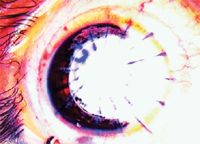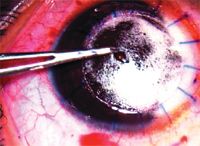Article
DLKP safe, effective option for keratoconus
Lisbon, Portugal—A deep lamellar keratoplasty (DLKP) procedure that exposes Descemet's membrane seems safe and effective to correct keratoconus, according to Mohamed Alaa El-Danasoury, MD, who reported his group's 1-year experience with the procedure.

DLKP is a new alternative technique to penetrating keratoplasty that Dr. El-Danasoury and his colleagues are using to treat almost all of their patients with keratoconus.
The identification of a new procedure is important in the Middle East because the country has a higher incidence of keratoconus than in Western countries, probably because of genetics and climate factors, Dr. El-Danasoury explained at the European Society of Cataract and Refractive Surgeons meeting.

"The main advantage of penetrating keratoplasty is the good visual outcome for these patients," Dr. El-Danasoury explained. "The outcomes can be improved by a second refractive procedure, such as LASIK.

Dr. El-Danasoury and colleagues reported on their 1-year results with DLKP, using the big-bubble technique, that was used to treat keratoconus in 50 consecutive eyes of 39 patients; a total of 368 patients have undergone this procedure. DLKP in this prospective, nonrandomized trial was performed by one surgeon at one site. The patients, all of whom had moderate to advanced keratoconus as well as an intact Descemet's membrane, underwent DLKP with injection of an air bubble into the pre-Descemet's membrane plane. Injection of an air bubble facilitates lamellar dissection, Dr. El-Danasoury explained.
"An air bubble is injected as deep as possible into the stroma. The goal is to push the air bubble between Descemet's membrane and the deep stroma in order to separate the two structures," he said. "A paracentesis is created to relieve the pressure. The bubble is punctured to allow the air to escape. A spatula is inserted through the same plane and any stromal fibers can be cut with blunt scissors. A sign that the surgery is proceeding successfully is that there is no resistance at all to the advancing spatula."

The air-bubble dissection technique was used in 39 eyes (78%); lamellar dissection was necessary in the other 11 eyes (22%). Descemet's membrane was bared in 97% of the cases in which the big-bubble technique was performed; in the remaining cases in which lamellar dissection was done, Descemet's membrane was reached in 63% of the eyes.
Newsletter
Don’t miss out—get Ophthalmology Times updates on the latest clinical advancements and expert interviews, straight to your inbox.




